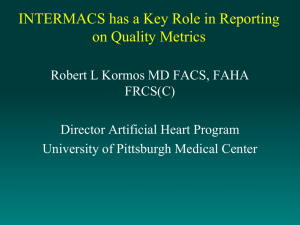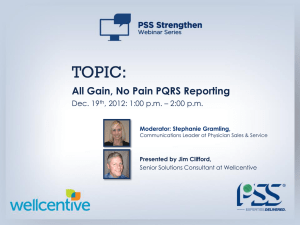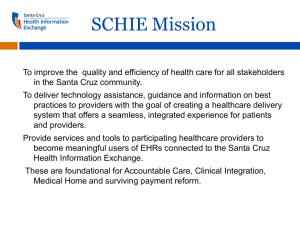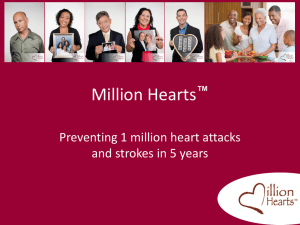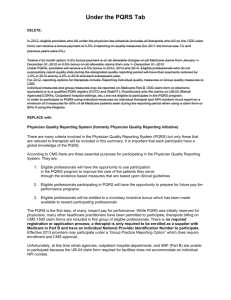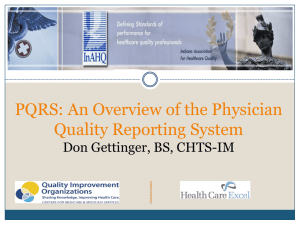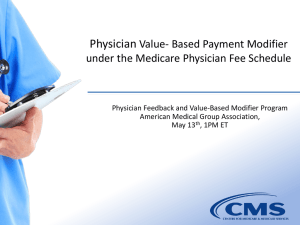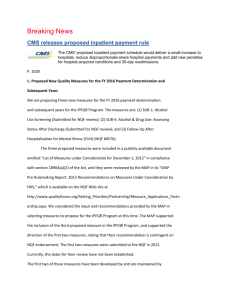Using Electronic Health Records (EHRs) for
advertisement
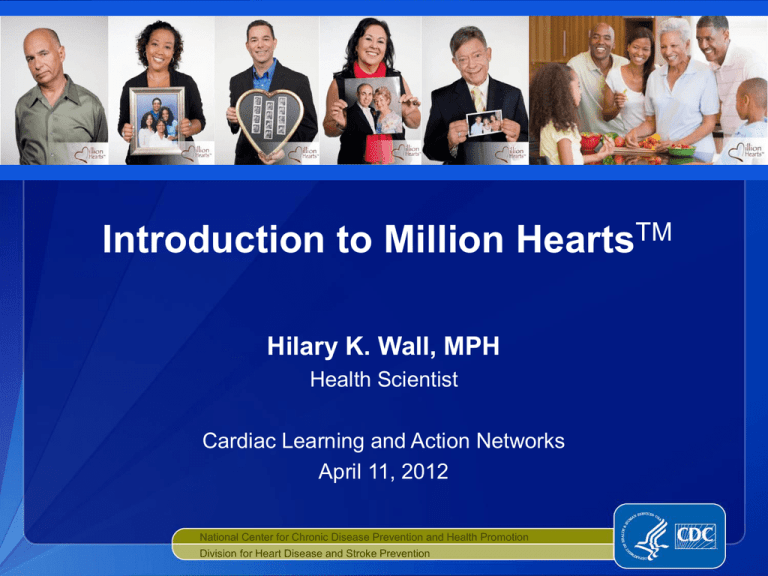
Introduction to Million HeartsTM Hilary K. Wall, MPH Health Scientist Cardiac Learning and Action Networks April 11, 2012 National Center for Chronic Disease Prevention and Health Promotion Division for Heart Disease and Stroke Prevention Burden of Heart Disease and Stroke Cause 1 of every 3 deaths >2 million heart attacks and strokes occur every year; 800,000 die Leading cause of preventable death among people <65 Treatment accounts for about $1 of every $6 spent on health care $444 B in health care costs and lost productivity Roger VL, et al. Circulation 2012;125:e2-e220 Heidenriech PA, et al. Circulation 2011;123:933–4 Improved cardiovascular care could Burden (cont’d) save 100,000 lives/year in U.S. 80000 Blood pressure control 60000 Cholesterol control 50000 (per year) Number of deaths prevented 70000 40000 30000 20000 Smoking cessation Aspirin 10000 0 20% 25% 30% 35% 40% 45% 50% 55% 60% 65% 70% 75% 80% 85% 90% 95% Percent eligible using service Farley TA, et al. Am J Prev Med 2010;38:600-9. 3 Status of the ABCS Aspirin People at increased risk of cardiovascular events who are taking aspirin Blood pressure People with hypertension who have adequately controlled blood pressure People with high cholesterol who are effectively managed Cholesterol Smoking People trying to quit smoking who get help 47% 46% 33% 23% Valderrama AL; Loustalot F; Gillespie C; George MG; Schooley M. Million Hearts: Strategies to Reduce the Prevalence of Leading Cardiovascular Disease Risk Factors — United States, 2011. MMWR 2011;60(36):1248-1251 Hypertensive Americans 65M hypertensives Uncontrolled and/or unaware – 37M Treated, not controlled – 17M Aware, not treated – 6M Unaware – 14M National Health and Nutrition Examination Survey (NHANES), 2005-2008 Percentage of Medicare FFS Beneficiaries with 15 Selected Chronic Conditions, 2008 Centers for Medicare and Medicaid Services. Chronic Conditions among Medicare Beneficiaries, Chart book. Baltimore, MD. 2011. Million HeartsTM Goal – prevent 1M heart attacks and strokes in 5 years Purpose – Engage public and private sector partners in a coordinated approach to: Reduce the number of people who need treatment Optimize treatment for those who need it Realize the full value of prevention in cardiovascular health http://millionhearts.hhs.gov/ MH Public Partners Centers for Disease Control and Prevention (co-lead) Centers for Medicare & Medicaid Services (co-lead) Administration on Aging Agency for Healthcare Research and Quality Food and Drug Administration Health Resources and Services Administration Indian Health Service National Institutes of Health, National Heart Lung and Blood Institute National Prevention Strategy, National Quality Strategy Office of the National Coordinator for HIT Substance Abuse and Mental Health Services Administration MH Private Partners American Heart Association America’s Health Insurance Plans American Medical Association American Nurses Association American Pharmacists’ Association and the American Pharmacists’ Association Foundation The National Alliance of State Pharmacy Associations and the Alliance for Patient Medication Safety The National Community Pharmacists Association Kaiser Permanente United Healthcare Walgreens The Y Association of Black Cardiologists American College of Cardiology National Committee for Quality Assurance National Consumer League American Association of Colleges of Pharmacy 9 Key Components of Million HeartsTM COMMUNITY PREVENTION Changing the context CLINICAL PREVENTION Optimizing care Focus on ABCS Health Information Technology TRANS FAT Clinical Innovations Focus on the ABCS Simple, uniform set of measures Measures with a lifelong impact Data collected or extracted in the workflow of care Link performance to incentives Alignment of Clinical Quality Measures 2012 PQRS PQRS CV Prevention Measures Group PQRS Group Practice Reporting Option ACOs Meaningful Use NQF Aspirin Use PQRS #204 Yes Yes Yes S1 optional, S2 core (prop) NQF #0068 BP Screening PQRS #317 Yes Yes Yes BP Control PQRS #236 Yes Yes Yes S1 optional, S2 core (prop) NQF #0018 Chol Control – Pop PQRS #316 S2 core (prop) TBD* Chol Cont – DM PQRS #2 Yes Yes Yes^ S1 optional, S2 optional (prop) NQF #0064 Chol Cont – IVD PQRS #241 Yes Yes Yes S1 optional, S2 optional (prop) NQF #0075 Smoking Cessation PQRS #226 Yes Yes Yes S1 core, S2 core (prop) NQF #0028 Million Hearts Clinical Quality Measures * The Measure Applications Partnership recommended it be submitted to NQF for endorsement (Jan 2012) Health Information Technology Registries for population management Point-of-care tools for assessment of risk for CVD Timely and smart clinical decision support Reminders and other health-reinforcing messages 14 Clinical Innovation Embed ABCS and incentives in new models Health Homes, Accountable Care Organizations, bundled payments Interventions that lead to healthy behaviors Mobilize a full complement of effective team members Pharmacists, cardiac rehabilitation teams Health coaches, community health workers, peer wellness specialists Role for Cardiac Learning and Action Networks Focus on the ABCS Create unique partnerships Be innovators Share best practices Successful QI interventions “Progress Notes” Million Hearts Resources http://millionhearts.hhs.gov/ Frieden TR, Berwick DM. The “Million Hearts” Initiative – Preventing Heart Attacks and Strokes. NEJM 2011; 365:e27. Valderrama AL, et al. Million Hearts: Strategies to Reduce the Prevalence of Leading Cardiovascular Disease Risk Factors --- United States, 2011. MMWR 2011:60(36);1248-1251. Tomaselli GF, et al. The American Heart Association and the Million Hearts Initiative A Presidential Advisory From the American Heart Association. Circulation. 2011;124:1-5. Questions? Hilary Wall – hwall@cdc.gov For more information please contact Centers for Disease Control and Prevention 1600 Clifton Road NE, Atlanta, GA 30333 Telephone, 1-800-CDC-INFO (232-4636)/TTY: 1-888-232-6348 E-mail: cdcinfo@cdc.gov Web: www.cdc.gov The findings and conclusions in this report are those of the authors and do not necessarily represent the official position of the Centers for Disease Control and Prevention. National Center for Chronic Disease Prevention and Health Promotion Division for Heart Disease and Stroke Prevention
